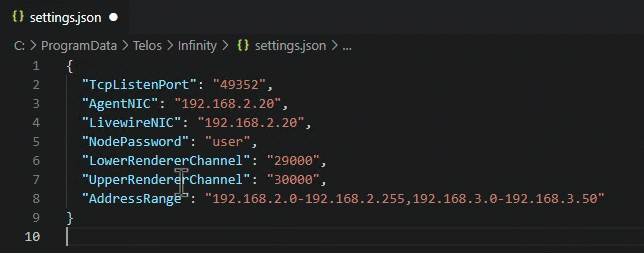Setting the password used for Livewire devices in Dashboard
Scope
This document covers the process to manually set the Livewire password for your Axia devices if changed from the default of blank (no password).
Description
When you initially install Dashboard software (Server or Application), you are prompted for some initial setup information that includes the user password for your system's devices.
After you install Dashboard, you may find it necessary to change this password.
Setting or changing the password
These settings (for Dashboard Application and Server) are changed by editing the settings.jasonfile in the C:\ProgramData\Telos\Infinity directory.
What are JSON files?
A couple of warnings before we start
- On the computer where Dashboard is installed, open Windows Explorer and navigate to the C:\ProgramData\Telos\Infinity directory and locate the settings.json file as shown here.

The ProgramData directory is likely a HIDDEN directory on your computer, and you will need to type this location into the address bar.

- Right-click on the settings file and chose Open

The following images may look slightly different. In this example, Visual Studio Code is used as our text editor. Your editor may differ, but the steps are the same.
Some or all of these settings may exist in your file depending on what you chose at setup.
{
"TcpListenPort": "49352",
"AgentNIC": "192.168.2.20",
"LivewireNIC": "192.168.2.20",
"NodePassword": "user",
"LowerRendererChannel": "29000",
"UpperRendererChannel": "30000",
"AddressRange": "192.168.2.0-192.168.2.255,192.168.3.0-192.168.3.50"
}- If the parameter "NodePassword" already exists, change the text inside the quotes after the : (colon) to match your password. If the "NodePassword" property does NOT exist, proceed to step 4.

- To add the "NodePassword" parameter, you must first add a comma after the last line and create a new line before the close curly brace symbol.
- Add the new line
"NodePassword": "SuperSecret". Replace SuperSecret with your password.

- Save your file.
If you are running the Application version (not the Server version) of Dashboard, you are done. The next time you open the application, the new settings are applied. If you are using the server version of Dashboard (where you access it via a Web Browser), you need to restart the Dashboard services.
Restating Dashboard Services (server version only)
- Press the Windows Key + R (or select run) from the Start menu.
- In the Open: box, type services.msc and click OK.

- When the Services window appears, scroll down and locate the Infinity.Agent and Infinity.Host services

- Right-click on each service and choose Restart.
Let us know how we can help
If you have further questions on this topic or have ideas about improving this document, please contact us.

